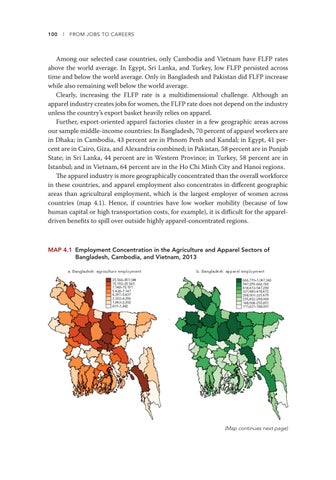100
l
FROM JOBS TO CAREERS
Among our selected case countries, only Cambodia and Vietnam have FLFP rates above the world average. In Egypt, Sri Lanka, and Turkey, low FLFP persisted across time and below the world average. Only in Bangladesh and Pakistan did FLFP increase while also remaining well below the world average. Clearly, increasing the FLFP rate is a multidimensional challenge. Although an apparel industry creates jobs for women, the FLFP rate does not depend on the industry unless the country’s export basket heavily relies on apparel. Further, export-oriented apparel factories cluster in a few geographic areas across our sample middle-income countries: In Bangladesh, 70 percent of apparel workers are in Dhaka; in Cambodia, 43 percent are in Phnom Penh and Kandal; in Egypt, 41 percent are in Cairo, Giza, and Alexandria combined; in Pakistan, 58 percent are in Punjab State; in Sri Lanka, 44 percent are in Western Province; in Turkey, 58 percent are in Istanbul; and in Vietnam, 64 percent are in the Ho Chi Minh City and Hanoi regions. The apparel industry is more geographically concentrated than the overall workforce in these countries, and apparel employment also concentrates in different geographic areas than agricultural employment, which is the largest employer of women across countries (map 4.1). Hence, if countries have low worker mobility (because of low human capital or high transportation costs, for example), it is difficult for the appareldriven benefits to spill over outside highly apparel-concentrated regions.
MAP 4.1 Employment Concentration in the Agriculture and Apparel Sectors of Bangladesh, Cambodia, and Vietnam, 2013
(Map continues next page)


